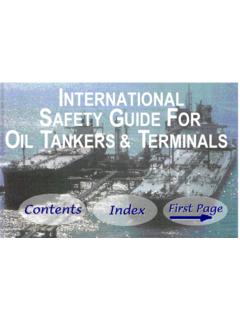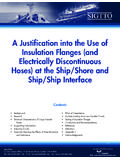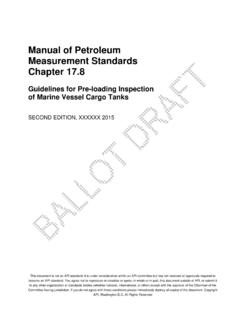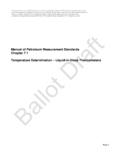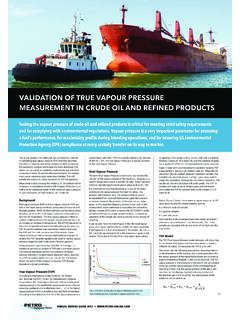Transcription of Appendix 1: Process for the management of …
1 Appendix 1: Process for the management of inadvertent ignition of explosive atmospheres by radio - frequency radiation Explosive atmosphere Note 1. OR Note 2. Apply Establish good Note 3 PD CLC/TR 50427 engineering and Note 4. operational practices Eliminate structures of Note 5. negligible risk N. Eliminate Y. special cases Note 6. N. Identify LW/MW. broadcast Note 7. transmitters Identify local fixed transmitters Note 8. Complete initial assessment Note 9. Explosive N atmosphere Note 10. outside of vulnerable zone? Y. Maintenance &. inspection Note 11. 1. Figure 1: Process for the management of inadvertent ignition of explosive atmospheres by radio - frequency radiation Notes to Figure 1.
2 Note 1: This guidance deals only with the ignition of onshore explosive atmospheres. Note 2: Duty Holders may choose to apply relevant good practice from first principles or they may choose to first consider how installations can be eliminated from further assessment due to their location, construction and operational practices. The latter option considers common safety measures and special cases prior to completing an initial assessment of risk. The result should be that resources are quickly targeted only at structures that pose a reasonably foreseeable risk. If the risks are not clear, then relevant good practice should be applied.
3 In either case, competent advice should be sought where necessary. Note 3: PD CLC/TR 50427, Assessment of inadvertent ignition of flammable atmospheres by radio - frequency radiation - Guide Note 4: Relevant good practice would include: avoidance of the interruption of circulating currents during normal operation by adequate bonding in explosive atmospheres (ref. BS EN 60079-0 clause );. managing work in explosive atmospheres (hot work) such that the interruption of circulating currents is avoided, for example by: o avoiding work in explosive atmospheres;. o avoiding the use of mobile cranes;. o bonding across flanges before removal of in-line equipment.
4 Note 5: Some structures are screened against radio - frequency radiation because of their construction. Such structures would include buildings with earthed metallic cladding. Note 6: Clause 12 of PD CLC/TR 50427 lists special cases where radio - frequency radiation may present a hazard, together with measures for addressing the resulting risks. When the relevant measures are in place, the special cases can be eliminated from further assessment. Onshore special cases are: cranes;. mobile and portable transmitters;. 2. ships - International Safety Guide for Oil Tankers and Terminals (ISGOTT) provided guidance on the control of ships'.
5 Transmitters. Note 7: As far as reasonably practicable, for example by using publically available information, identify the frequency and power of long wave and medium wave radio broadcast transmitters within the maximum vulnerable zone distance defined by Table 7 of PD CLC/TR 50427, specifically: gas group IIA: km;. gas group IIB: km;. gas group IIC: km. Note 8: As far as reasonably practicable, for example by using publically available information, making reasonable enquiries and visually surveying the local area, identify the frequency and power of fixed transmitters ( radio beacons & radar) in the immediate vicinity.
6 Note 9: Compare transmitter details with those in PD CLC/TR 50427 Table 5. and elect the worst case equivalent transmitter. Note 10: Read off the size of the vulnerable zone for the most sensitive gas/vapour on the plant from PD CLC/TR 50427 Table 5 or 6 as appropriate. Note 11: Installations should be subject to periodic maintenance and inspection to ensure that safety measures remain effective. Activities would include, but need not be limited to, monitoring of bonding and auditing of procedural measures. 3.










